EXCLUSIVE BACK ISSUE EXCERPT: Roy Thomas, Jerry Ordway and Arvell Jones talk All-Star Squadron. PLUS: Dig Joe Staton’s glorious JSA…

Do you miss the Justice Society of America? Yeah, me too.
One of the biggest frustrations long-time fans had with DC’s New 52 initiative seven years ago was that it pretty much took the publisher’s classic Golden Age characters off the board. Sure, there was Earth-2, but that modern reboot was too far afield to satisfy a lot of readers who were accustomed to the original versions of Green Lantern, the Flash, et al.
The JSA and the rest of the company’s Golden Age characters are still largely in limbo because Geoff Johns and Gary Frank have plans for them in Doomsday Clock, but it’s going to take a long time for the Watchmen sequel to play out.
Perfect time, then, for the new edition of Michael Eury’s Back Issue, which comes out from TwoMorrows on 7/25. The issue is dedicated to the Golden Age in the Bronze Age and includes interviews and features on Adventure Comics, All-Star Squadron, the Spectre and much more. And it’s not all DC either: Issue #106 also explores Marvel’s attempts at mining its history.
Just check out the table of contents:
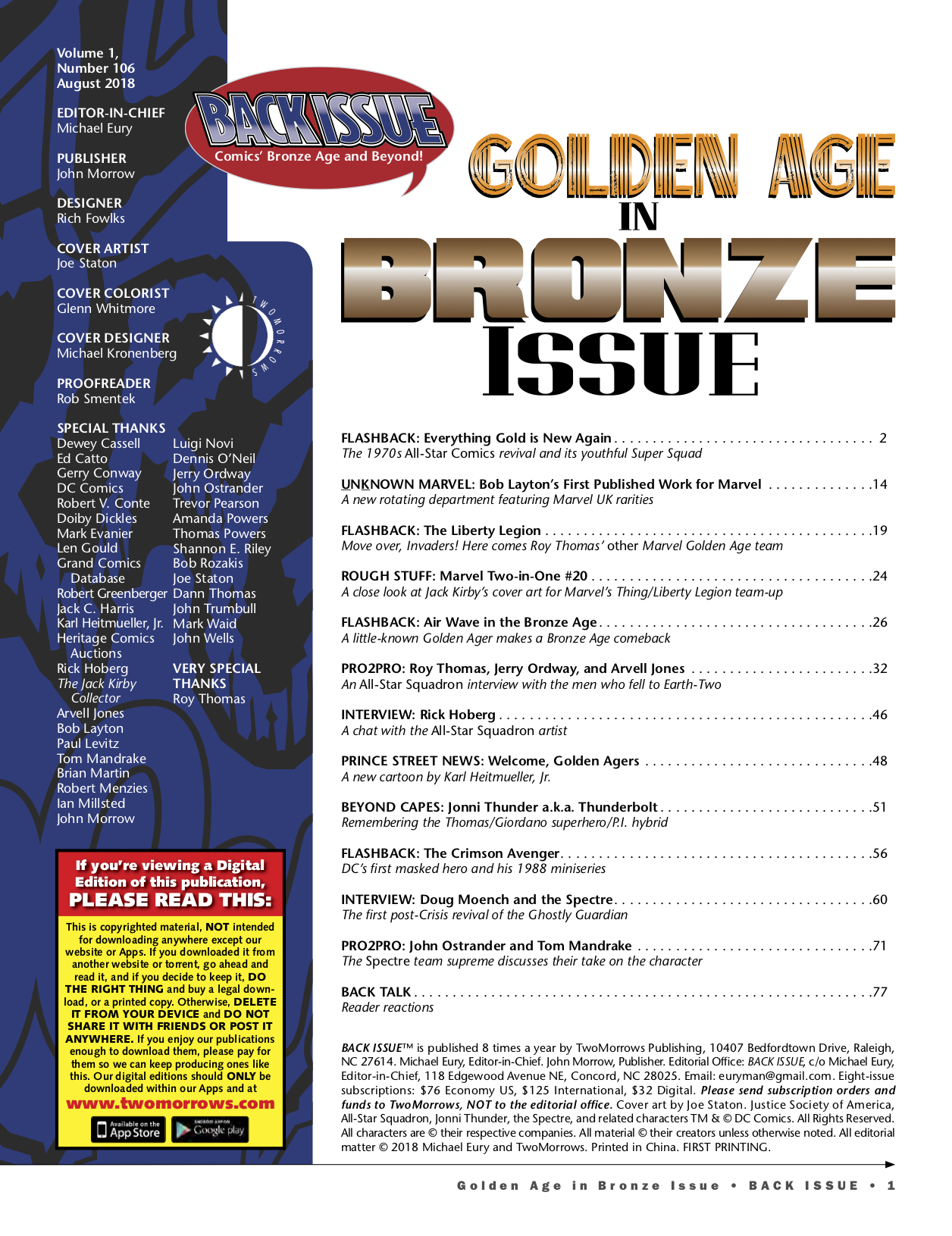
Seems fitting that this is coming out in the summertime given how popular the JLA-JSA team-ups used to be this time of year. (Click here for more on that.)
As usual, there’s a lot of great stuff in there – and for this issue’s EXCLUSIVE EXCERPT, we’re going to give you a glimpse of Eury’s interview with Roy Thomas, Jerry Ordway and Arvell Jones on All-Star Squadron, conducted at a convention panel last year.
This is only a fraction of the discussion, so make sure you pick up the issue when it hits comics shops on 7/25. (You can also buy it directly from TwoMorrows. Click here.)
—
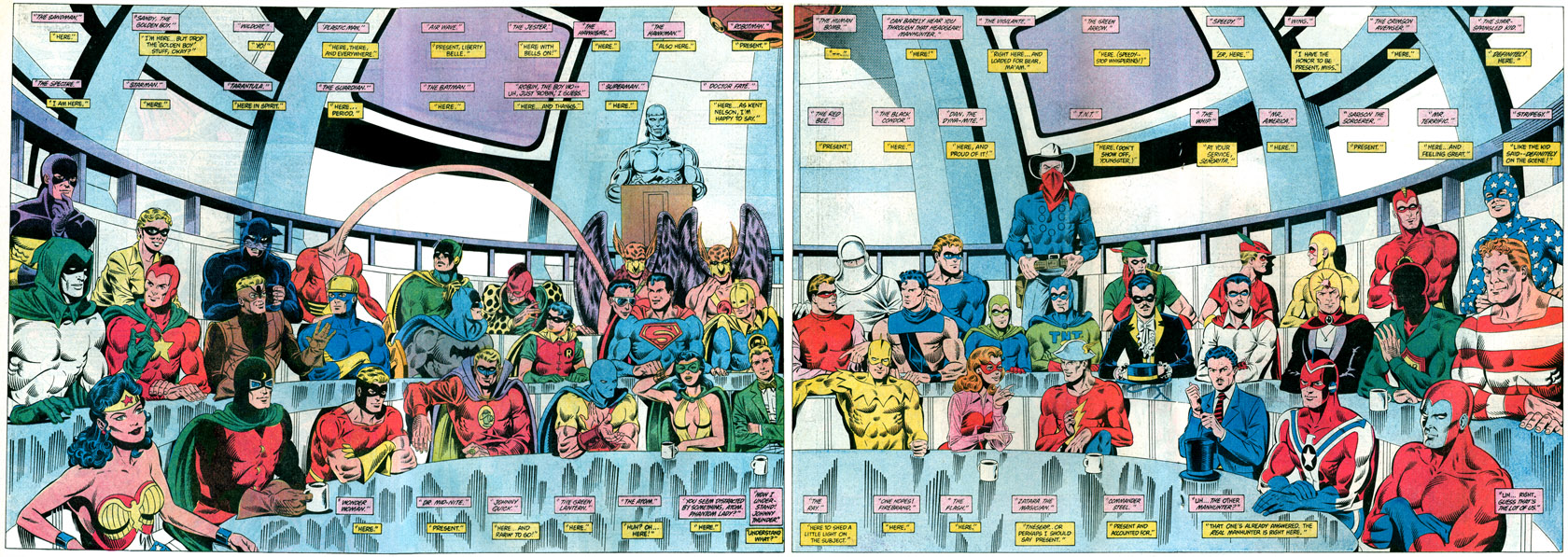
From All-Star Squadron #31. Art by Rick Hoberg and Mike Machlan.
Michael Eury: Roy, we’re going to start with you. You’ve told this story many times before, but for the record, how did All-Star Squadron come about?
Roy Thomas: I just wanted to do it, you know. I had just left Marvel, and DC wanted to keep me happy but they didn’t really want a Justice Society comic, because the Justice Society comic that Paul Levitz had been writing at the end had just died in the previous year or two, and I didn’t really want to revive it. I loved that group, but just bringing it back again a year or two later… I could have done it, but…
I had been doing Invaders at Marvel for a number of years and I just got into the thing where I sort of liked doing World War II comics.
I didn’t want to just write the Justice Society, I wanted to write everybody. Everybody, every character that ever existed at DC, maybe a few more. So, I talked them into the idea of the All-Star Squadron, and that’s how it happened. It was a good seller for the first couple of years.
When Ordway wandered off it didn’t help anything, but we struggled on. Arvell came aboard and we had some other good artists. It did OK. If it hadn’t been for that damn Crisis, it might still be going. We’d be up to about issue three or four hundred and I might even have gotten to 1943. [Laughter]
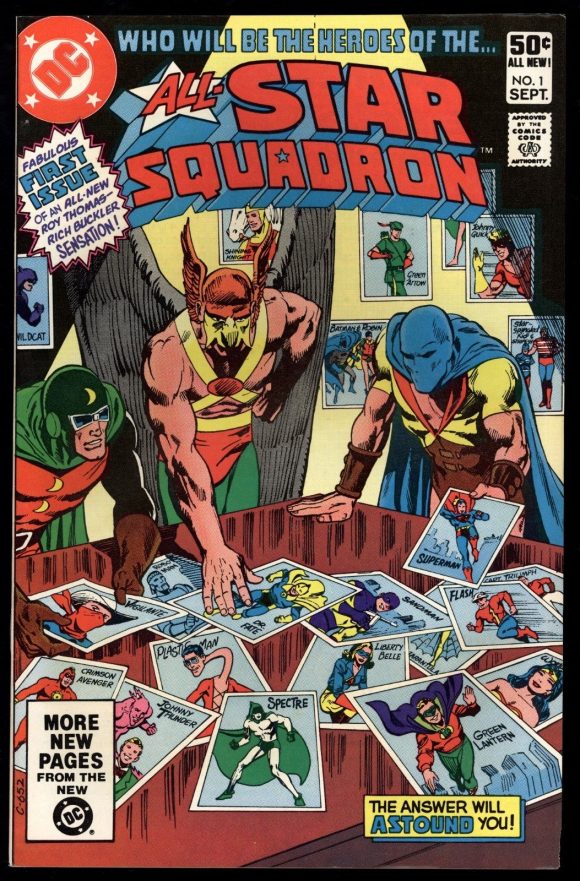
Rich Buckler pencils, Dick Giordano inks.
Eury: Was there any opposition to setting it during World War II? Because the last time the Justice Society had been seen, they were set in contemporary times.
Thomas: No, there really wasn’t a lot. I think probably because the previous JSA comic, having just failed in the present, made it easier for me to do despite the fact that Invaders had never been a huge hit. I was not under the illusion that All-Star Squadron was going to be the biggest hit ever—that was not my interest.
I had very little interest in my audience anymore. If my audience was interested in what I wanted to do, and I had made them interested enough for me to make a living… but other than that, I had zero interest in writing comics for anybody except myself. But I had to fool the publisher and the editor into thinking that I did, and it sort of worked.
It was a reasonably popular comic, and I think I probably did some things that didn’t make it more popular. Like having a cast of 80 people, or maybe not focusing on the same four or five or six over and over, but that wasn’t my interest. You know, I was interested in a tapestry, not just the usual group where you’ve got four or five people and a few others. I wanted to be dealing with everybody, and I was aware how risky that was and that it might not work. It lasted [67] issues, and then the Young All-Stars for another 30 issues after that. It wasn’t a bad run, and again, if it hadn’t been for Crisis it probably would have limped along, gotten back on track, and done well again.
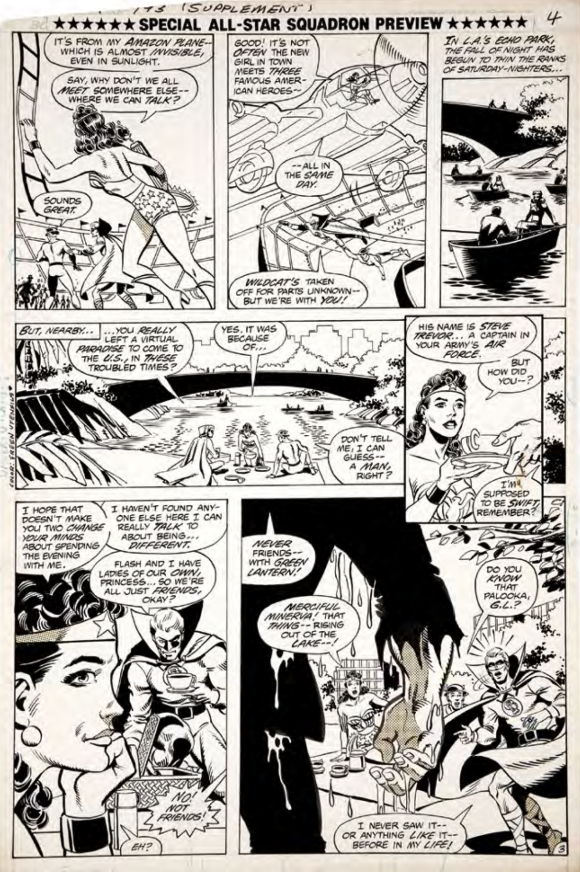
From the All-Star Squadron preview story in JLA #193. Pencils by Buckler, inks by Jerry Ordway.
I was very lucky in the artists that I had. (Rich) Buckler and Jerry in the beginning, then Jerry turned out he could actually draw! [Laughter] First when they wanted him to, they said Jerry’s going to draw it, and I said, “Whaaat!?”
We knew he could ink, and then I saw a few pages that great. Then I went to Arvell and a few other people later on to pick up the slack after Jerry left. In between we had Rick Hoberg, who did a really nice job for a while, and a few other people.
Eury: Adrian Gonzales… [Adrian Gonzales penciled issues #6–18 as well as Annual #1.]
Thomas: Yeah, Adrian Gonzales, he was really good, and especially, of course, there Jerry became really important, because Adrian did a pretty good job of storytelling and Jerry tied it together to give it that slick look. Well, he’ll tell you more about it.
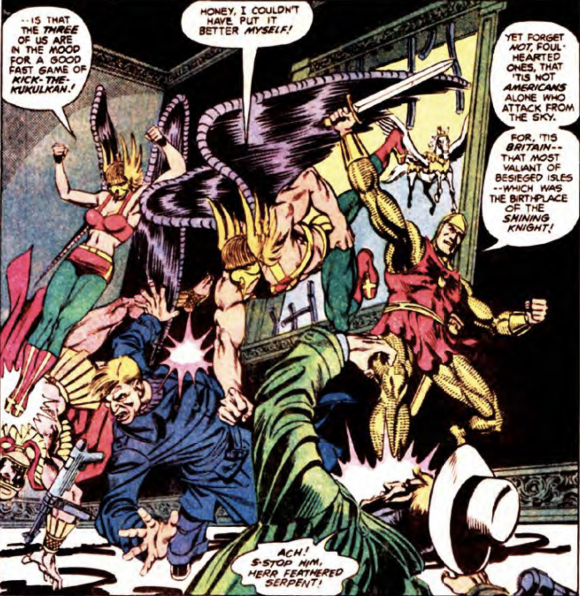
From All-Star Squadron #6. Pencils by Adrian Gonzales, inks by Ordway.
Ordway: Right. Adrian didn’t really have the same connection. I’d already been on it for a while, so I kind of understood the main characters and their appeal or whatever. So I think that was a big deal. Also costumes. I still think of that when I’m doing a sketch.
Thomas: I was a little particular about costumes.
Ordway: But you know what, it made me think about it, too. I was drawing the Golden Age Green Lantern recently and I was like, “Wait, he’s left-handed,” and I remember that because—
Thomas: I don’t remember that.
Ordway: —I always thought about it. Then Jade became left-handed with Infinity, Inc.
Thomas: You remember that?
Ordway: That was the great thing. When I first started on the book, Roy, I was the finisher, I was the new guy, but I remember getting a box of like reference stuff—Xeroxes.
Thomas: That was just for one issue! [Laughter]
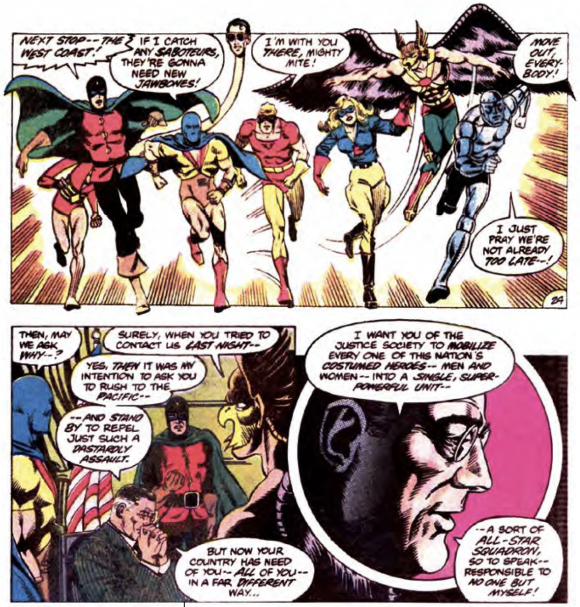
From the first issue. Pencils by Buckler, inks by Ordway.
Ordway: It was literally a big box full of stuff including Xeroxes out of books. Nowadays, with the ability to Google something, it would be so much easier, but basically in those days it was hard to transport reference short of going to the library and finding the same book.
But, yeah, when I got the project I had started at DC, I was part of the talent search in 1980, the summer of ’80. I got work—Joe Orlando chose me, Paul Levitz chose me—and I got a few little jobs during that summer. Then I got a call from Paul and he said, “Would you like to ink the Teen Titans?” I really didn’t want to. I had a full-time job—I was working in an art studio—so it didn’t appeal to me in that sense like, I wasn’t going to quit for it.
And then, a couple of months passed. I think at that point [editor] Len Wein called me and said, “There’s this project that Roy Thomas and Rich Buckler are doing, All-Star Squadron.” And then it was like, “Wow…” I was such a huge fan. During my Marvel years, The Avengers was my favorite book, so I was like, “This is Roy Thomas. It’s a team book. This should be great.”
Thomas: You would have been better off to go with Teen Titans. [Laughter]
Ordway: You know, at the time I didn’t realize… I would have displaced Romeo Tanghal [on New Teen Titans], so it would have made me a little uncomfortable. But it wasn’t the right time, anyway. It was just timing, but it was the idea of working—and again, the Avengers stuff that Roy did.
Roy was the guy. When I was a reader he used Hawkeye and a lot of the second-string characters. He made them into the star attraction, which to me was always the key to All-Star Squadron. The core group was Liberty Belle, Johnny Quick, and Robotman—nobody really knew them that well, but Roy fleshed them out, made them real. That, to me, was the core of the book, the fact that you had second-stringers who were carrying it and the Justice Society came in and guest-starred and it’s like, “George Clooney’s in this episode,” or whatever, it really was that.
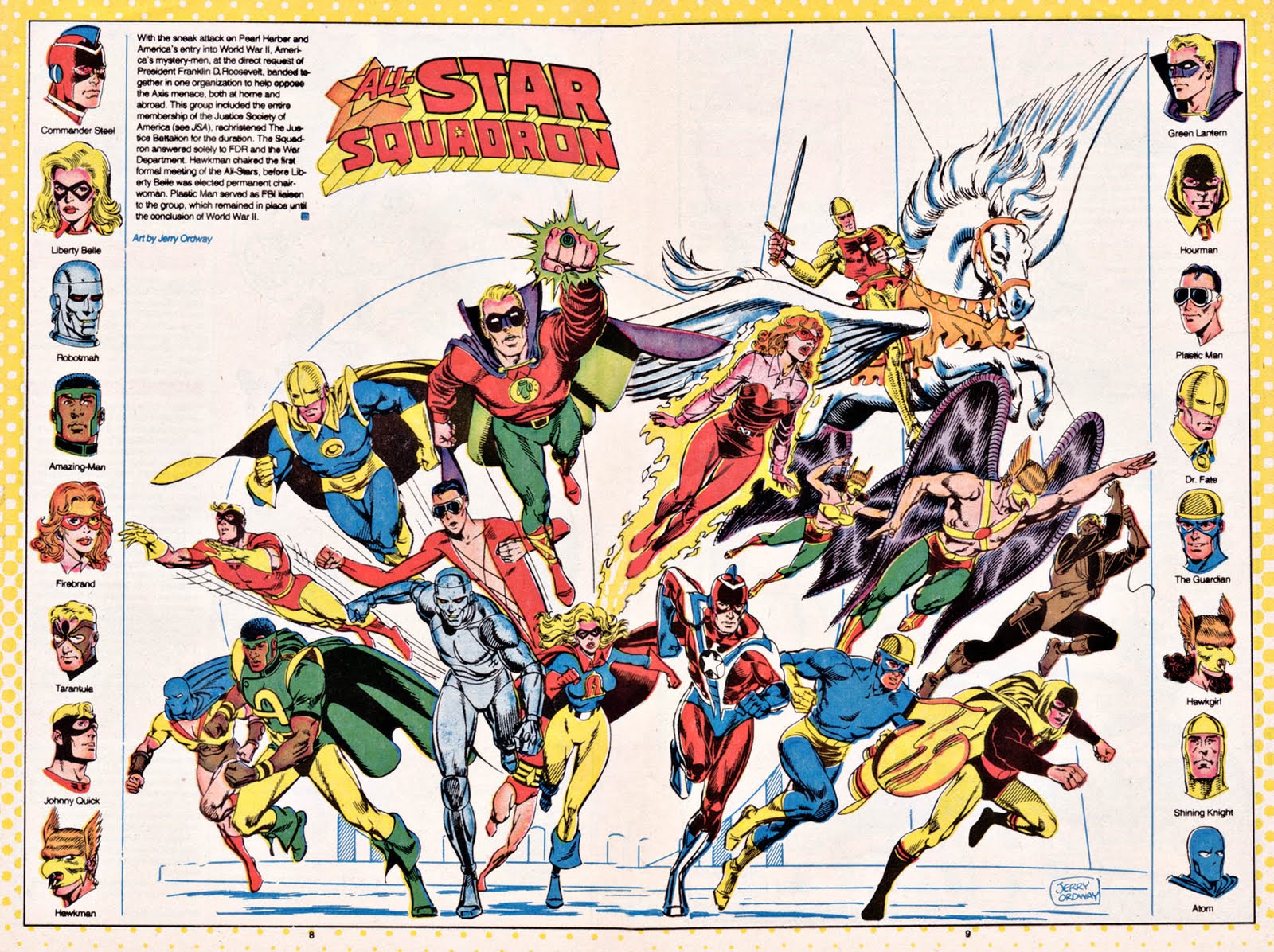
Who’s Who entry
Eury: Roy, why did you choose those particular characters early on?
Thomas: I felt that those guys were the best of the non-Justice Society characters. For one thing, I tried to choose the ones that had a superpower for the most part, because there were a lot of characters… I could have gotten Aquaman, Green Arrow, or a lot of Batman types.
You get one or so in a group, it’s OK —you get three or four, it’s just a bunch of guys with masks on fighting.
But these others—the Shining Knight had his winged horse and his sword. Firebrand was a new character we thought up. Liberty Belle… we needed a woman in there. Johnny Quick, I always loved.
First of all I discovered, especially by the time I was an adult, that Johnny Quick had been drawn so much better than the Flash, especially in the early ’40s when Mort Meskin was doing it before Carmine [Infantino] and Lee Elias and Joe Kubert came in.
Who was the other one? Oh, Robotman… I’d always loved him. I stuck Plastic Man in, but somehow, he never quite worked out.
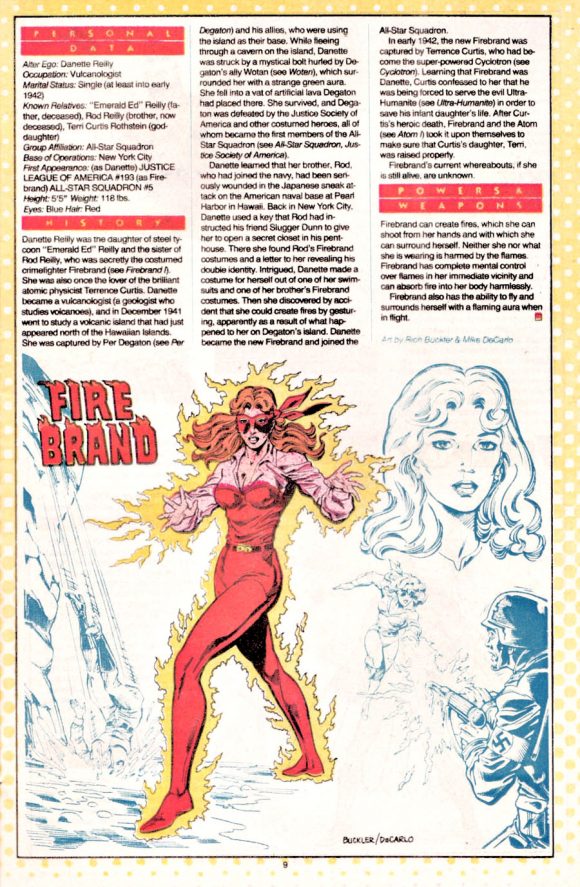
Who’s Who entry
Ordway: And Fire—
Thomas: Firebrand. She was a new character, because we needed another woman and I just thought, “Let’s swipe the Human Torch and turn him into Firebrand,” because [the original] Firebrand was not much of a character.
Ordway: He was a guy in a pink see-through shirt.
Thomas: We had to change that a little bit. [laughter]
Arvell Jones: You still went with the see-through shirt—you just added a bustier. [Laughter]
Eury: Roy, how did Rich Buckler get chosen as the book’s original artist? Did you choose him?
Thomas: No, Len [Wein, All-Star Squadron’s original editor] did the choosing, although Rich and I worked together a lot and Len knew that I would like that.
(Later in the interview, Jones explained how he got on the book.)
—
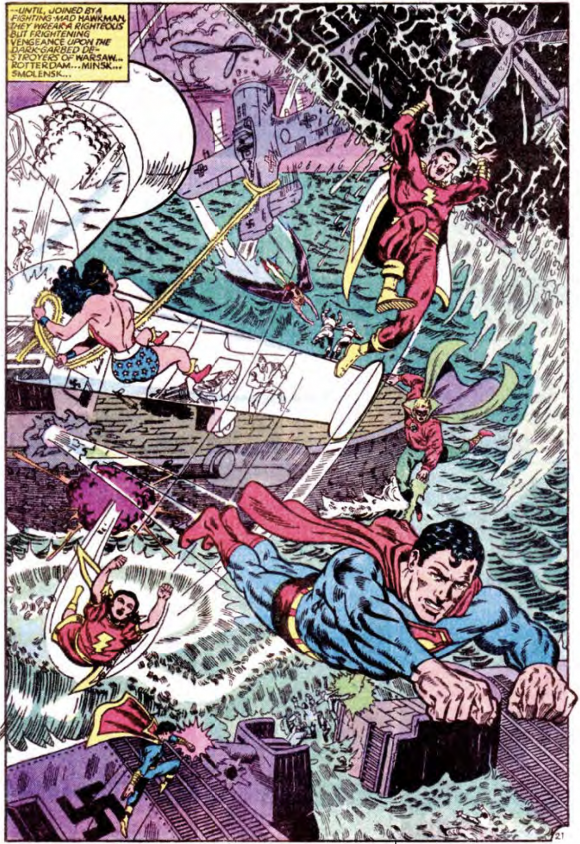
From Issue #37. Pencils by Arvell Jones, inks by Richard Howell.
Jones: After getting in over at Marvel and doing a little drawing, I was all excited. Stan was there, Roy was there, all the legends. All right—I’m working with the legends!
Then one day Roy calls me up and says, “I’m going to DC. I’ve got some pitches, I want you to do a little bit of artwork.” So, I did some layouts, I got them to him, and he said, “Thank you.” Then I didn’t hear anything else from him! [Laughter]
Those rough layouts were for Captain Marvel and some Justice Society book, and I think I still have the originals around here somewhere.
Sometime later on, I saw the book that Rich and Roy were doing and I said, “Aw, man!” I was a fan of the Golden Age stuff as well, and I just watched it and got excited. Then one day Roy just called me up and said, “Hey, I’ve got an issue of All-Star Squadron. I wonder if you could help us out?” I said, what do you need? “Well, Rich can’t finish the second half of a two-parter” [Issue #37]. I said, “I’m on it—what is it?”
He said, “It’s Superman vs. Captain Marvel/Shazam. What do you think, do you think you’d like to do that?”
I said, “YEEESSSS!” [Laughter] I just fanboyed completely out. “GIVE IT TO ME!”
So he gave it to me.
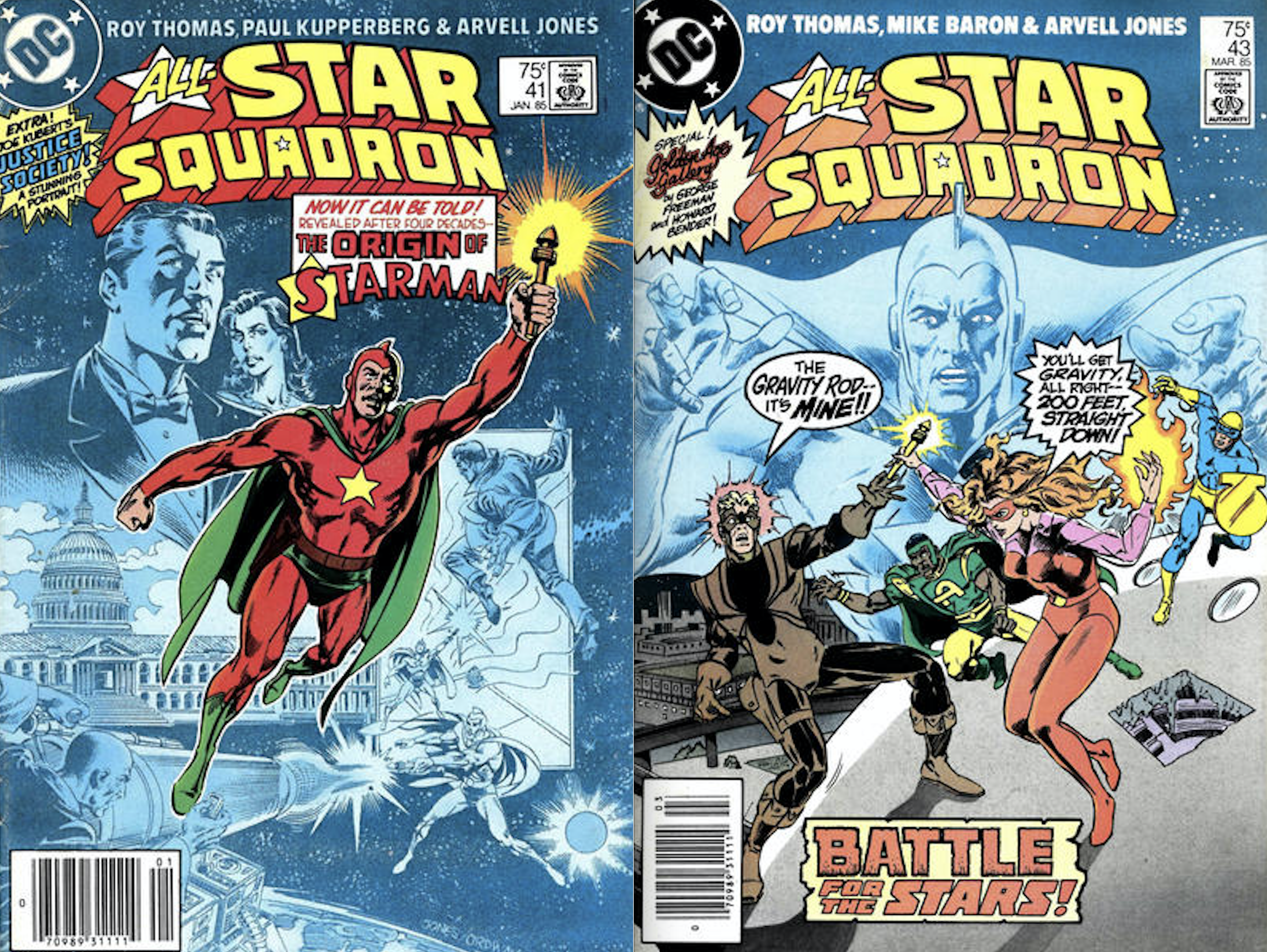
Pencils by Jones. Inks by Ordway on the left, Tony DeZuniga on the right.
Thomas: Plastic Man was in it.
Jones: Yeah, Plastic Man was in there… Mary Marvel and Captain Marvel, Jr. I just got excited. After I did that issue, I guess Roy kind of liked it and asked me on the book.
At the time I was a little busy, getting ready to get married, working at the TV station. I was just offered the job as a news producer. So Roy gave me one issue, and then he said, “How would you like to do Starman? He’s never had an origin.”
I said, “Really? Yeah, Starman has always looked cool to me with the big star and everything.” So he gave me that to do [All-Star Squadron #41].
Then he calls me up and he goes, “You’re a big Kirby fan, aren’t you?” And I said, “Yeah.” He said, “Name a Kirby character you’d like to do.” I said, “I always liked the Guardian.” So the next thing you know, I get this script it’s got the Guardian in it [All-Star Squadron #43].
I said, “Roy, I’m not George Pérez. Please don’t put a whole lot of characters in there.” [Laughter]
—
Back Issue #106 is out 7/25. It’s available at your comics shop or directly through TwoMorrows. (Click here.)
—
MORE
— 13 JLA-JSA COVERS to Make You Feel Good. Click here.
— THE JOYS OF SUMMER: 13 Great Comics Memories. Click here.

July 15, 2018
This was a cool interview.
July 16, 2018
Those two double-page spreads in All-Star Squadron #31 were pure magic. I actually remember the day I bought that comic! It was an early dismissal snow day, and my Mom stopped by a local gas station to get some bread on our way back from school. I found that issue there, and it rocked my world. SOOO many heroes in one issue!!! Can’t wait to read this magazine!
July 17, 2018
It’s amazing how much we remember about the circumstances surrounding certain issues we got when we were kids…